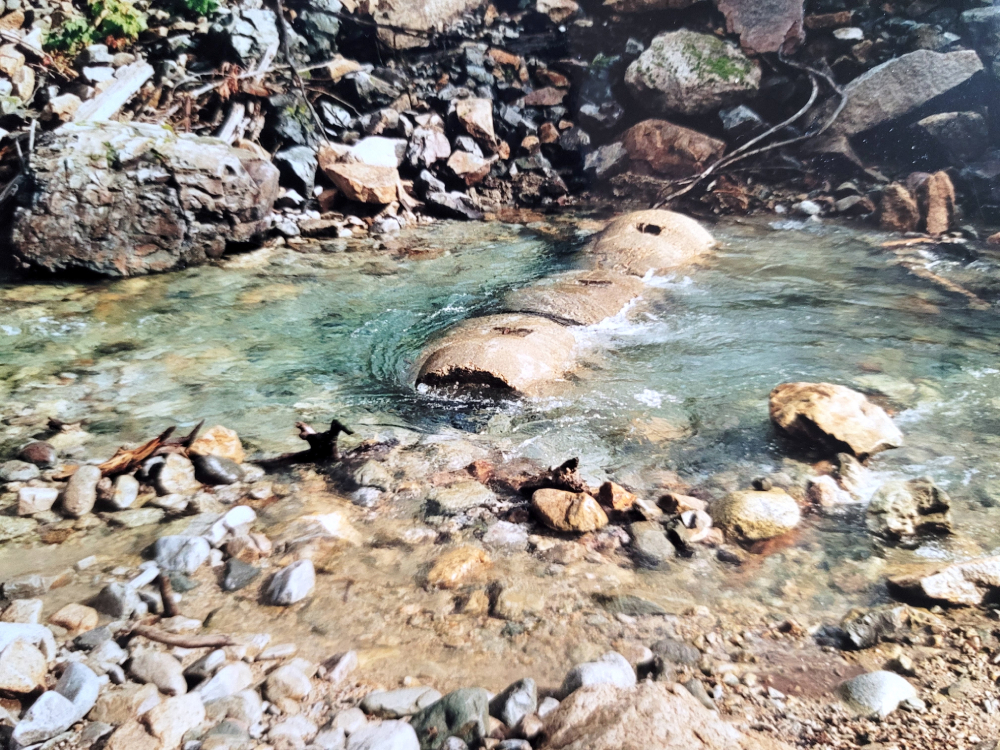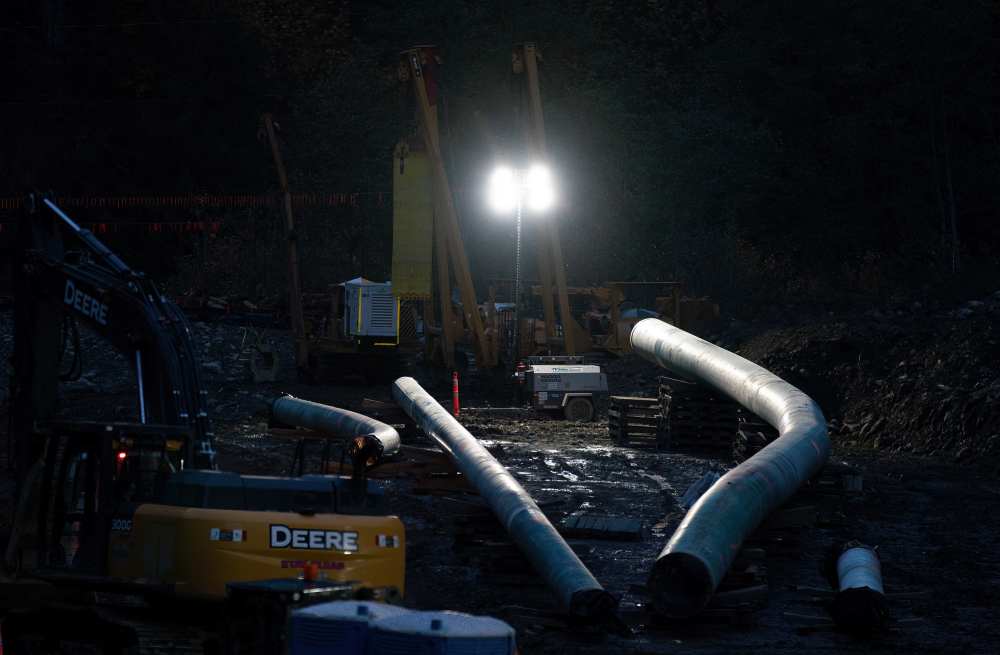Romilly Cavanaugh stood at the edge of the Coquihalla River north of Hope, watching big trees snap off the bank like blades of grass in a lawn mower. Some of those not swept away held dead fish in their branches three metres off the ground — a reminder of what came before.
Cavanaugh and her fellow engineers had been sent into the chaos for a sole purpose: to watch the Trans Mountain pipeline through the flood of 1995.
Over that week they held vigil in torrential rain because the pipe, usually buried in a thick blanket of soil and rock, was bare and moving up and down in the river “like a piece of cooked spaghetti.”
That was new to her. “You don’t expect metal structures to be moving.”
On the other side of the river was a less visible danger. Enbridge’s Westcoast gas pipeline also had escaped its casing, leaving it at the mercy of rushing water.
Cavanaugh left her job at the company decades ago and now works as an independent environmental engineer. But such memories worry her. “I’ve been watching the news for the last couple days, just praying that we don’t see an oil spill on top of everything else we’ve already seen.”
“It was chaos. And it’s even worse now.”
After massive floods and landslides hit the province last week, the Trans Mountain and one of three Enbridge pipelines were shut down, although oil and gas continued to sit in the pipes.
So far, neither company has reported a leak, but Trans Mountain confirmed in a statement yesterday that the pipeline has sustained damage.
“There are some areas where Trans Mountain will need to restore or cover over the pipe or make other repairs to ensure integrity of the line where it has been exposed due to flooding,” the company said in a statement.
It added that in some areas, rivers began flowing over the pipeline right of way. Workers are now attempting to redirect rivers into their normal channels.
“If all planning and work continues to progress and no further issues with the pipeline are assessed, Trans Mountain is optimistic that we can restart the pipeline, in some capacity, by the end of the week,” the company stated on Monday.
The restart would depend on access to equipment, weather and there being no new “findings of concern,” it added.
The Enbridge pipeline affected by flooding resumed operations yesterday.
Trans Mountain has said its pipeline expansion now being constructed is designed to withstand a 10-per-cent increase in flood activity to account for climate change. Research suggests that will likely be insufficient.
The Trans Mountain pipeline that is being twinned traverses one of the country’s main drainage basins — and flooding hotspots — in the Fraser-Lower Mainland region.
The Coquihalla and Coldwater rivers, which Trans Mountain follows, “are the most dangerous spots for a potential spill from a flood like this,” said Cavanaugh.
“The rivers are really fast moving, and the pipeline is super close to the river — it goes under it in several locations.”
When completed, Trans Mountain’s expansion project will triple the amount of oil flowing through its pipes to over 890,000 barrels per day.
Mayuk Manuel, a member of the Tiny House Warriors, a movement resisting the Trans Mountain expansion project, reports seeing Trans Mountain construction sites abandoned on the highway driving up to Hope.
In some regions, empty pipeline trenches had been turned into muddy rivers.
“There was so much erosion from how fast the water was moving,” she said. “How risky is this? Are we willing to take that risk?”
Kai Nagata, energy and democracy director at the Dogwood Initiative, said the construction zone has sustained damage. “The path of construction has been just hammered by debris slides and covered in mud in a bunch of different places, and the access roads are washed out.”
The government-owned project has faced three delays in just over a year, pausing for safety incidents, COVID and wildfires. That’s upped an already-dubious investment, said Nagata.
“The whole equation around using public money to build Trans Mountain deteriorates every time the project encounters a delay, and this is a significant delay with no end date in sight.”
Crews working on the project in the Coquihalla and Merritt regions have been redeployed to get the existing line back into operation, said Trans Mountain in an emailed statement, adding that it had not evacuated any of its work camps.
‘We account for this’
Dharma Wijewickreme, a professor in geotechnical engineering at the University of British Columbia and founder of the Pipeline Integrity Institute, is firm in stating, “Based on the available information, I think it’s fair to say pipelines are one of the safest ways of transporting fluid over long distances.”
But Wijewickreme also acknowledges the risks that floods pose to pipeline infrastructure.
Key among those issues is the power of soil, which under landslide and flood conditions can push the pipeline in different directions from underground.
“When that happens, the pipelines will be subjected to deformations,” he said. Such pressures can cause the pipe to pop up or bend.
The type of soil also presents a risk factor, said Wijewickreme. Areas with soft sedimentary soils, like the Fraser Valley, can increase risks to the line.
And when buried underneath rivers, pipelines are at risk of “scouring,” as fast-moving rivers scrape off the rock and topsoil meant to keep pipelines buried underground.

None of these dangers are new, said Wijewickreme. “When you design pipelines, normally as engineers, we account for this.”
He described a number of new methods he and colleagues use, including burying pipes deeper underneath waterways and reinforcing pipeline walls. Engineers also design pipelines so that they’re thicker in areas where the pipe has to withstand greater pressure, like under river crossings.
Still, flood-related spills happen.
In June 2013, Alberta suffered a major flood, triggering two spills linked directly to the disaster. That included a sour gas leak on Legacy Oil and Gas’s company’s line, caused by a puncture from floating debris to an exposed pipeline. The leak led to evacuation of 2,100 residents living nearby.
Later, a spill in northeast Alberta on Enbridge’s Wood Buffalo pipeline system spilled around 750 barrels of crude oil. At the time, the company pointed to heavy rainfall that led to the kind of underground soil movement that Wijewickreme highlighted.
When floods block access
Back at the riverbed during the flooding of 1995, Cavanaugh and her team watched with trepidation. If they did witness a leak, there would be little to do but warn those downstream.
That’s the danger of compound disasters like oil spills and floods happening simultaneously, she said. Clean up crews are subject to safety precautions and won’t be sent into a disaster zone to quell an oil spill.
“If there’s a spill, an evacuation, or if the spill occurs in a fast-moving river, no amount of equipment will help you if you can’t get there,” she said.
Road access presents another issue. Although Trans Mountain has access to networks of back country roads and bridges leading to the pipeline right of way, those roads can easily become obstructed.
In the 1995 flood, Cavanaugh said damage to roads and bridges “took years for them to recover.”
During the National Energy Board hearings for Trans Mountain expansion project, the Sto:lo Collective raised concerns about the risks of natural hazards such as flooding and landslides in the Fraser Valley, citing incidents like the floods on the Fraser over the decades.
Trans Mountain responded saying that the project was designed to withstand hazards and would “implement mitigation measures where avoidance was not possible.”
But Cavanaugh questions the power of cleanup measures. An effort that managed to salvage 10 to 15 per cent of leaked bitumen mixed with toxic diluting agents would be considered “successful spill response in a river,” she said.
So far, B.C.’s devastating flood hasn’t triggered any pipeline ruptures, but the climate crisis promises to make floods more severe, and more frequent.
As Tara Troy, associate professor in hydrology at the University of Victoria, puts it, “If a flood is bad luck, then climate change increases your probability of bad luck.”
In seeking approval of its pipeline expansion, Trans Mountain committed to meeting provincial requirements that the pipeline be designed to withstand a level of flooding at one-in-200-year levels on water crossings, with higher standards on three individual rivers.
Flooding in the Merritt region last week likely surpassed that level, said Brett Eaton, a fluvial geomorphologist at the University of British Columbia.
It’s also unclear whether those design standards apply to sections of pipeline that don’t cross water bodies, but may run alongside them, and became inundated by water in the floods Cavanaugh witnessed, and last week.
Trans Mountain was not able to provide clarification by press time.
And the company’s proposed design fix to account for a 10-per-cent increase in flood activity from climate change might not be sufficient.
A 2021 study of the climate impacts of flooding in Canada found that the Fraser-Lower Mainland region would see a 20-per-cent increase in 200-year floods in the near future, and a 30-per-cent increase in such floods from 2061 to the end of the century.
Nagata says there’s an obvious need to reassess risks posed by the Trans Mountain pipeline and expansion.
“Nobody expected the Coquihalla to just melt,” he said, “All of the concerns that have been raised by critics of the project over the last 10 years I think have to be looked at again and taken seriously.”
Wijewickreme remains optimistic that pipelines can be the safest way to transport fossil fuels and other chemicals, as long as those who design and build them pay attention to climate science.
The way weather is trending, he said, damages “could be more than anticipated at the time of design.”
Cavanaugh is less sanguine. The engineer watches the current devastation and reflects back to the flood of 1995 that left her shaken. Last week’s deluge is “on a completely different scale,” she said, not only in terms of levels but areas affected.
“Instead of funding the Trans Mountain pipeline expansion we should be reinforcing infrastructure and planting trees and looking for jobs and things for people to do,” she said. “It’s very frustrating.” ![]()
Read more: Energy, Environment

















Tyee Commenting Guidelines
Comments that violate guidelines risk being deleted, and violations may result in a temporary or permanent user ban. Maintain the spirit of good conversation to stay in the discussion and be patient with moderators. Comments are reviewed regularly but not in real time.
Do:
Do not: